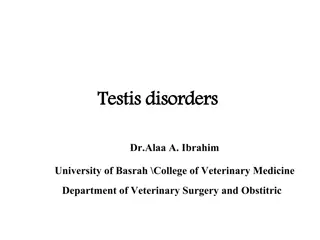Pituitary Disorders
Pituitary disorders, often caused by tumors, can disrupt hormone production leading to various symptoms like weight gain, vision problems, and hormonal imbalances. The pituitary gland plays a crucial role in regulating bodily functions through hormone secretion. Factors such as tumor growth, head injuries, and genetic defects can contribute to pituitary disorders. Various conditions like gigantism, acromegaly, and prolactemia can arise from pituitary dysfunction, with distinct causes and symptoms. Diagnosis involves specific tests like MRI, and management includes medication, radiation therapy, and surgery to regulate hormone levels.
Download Presentation
Please find below an Image/Link to download the presentation.
The content on the website is provided AS IS for your information and personal use only. It may not be sold, licensed, or shared on other websites without obtaining consent from the author. Download presentation by click this link. If you encounter any issues during the download, it is possible that the publisher has removed the file from their server.
Presentation Transcript
University of Baghdad University of Baghdad Nursing college Nursing college Pituitary Disorders Prepared by : Khadija Mohammed Prepared by : Khadija Mohammed Jassim Jassim Supervisor : Prof. Dr. Supervisor : Prof. Dr. Sabah Ahmed Sabah Ahmed
Pituitary disorders occur when the pituitary gland makes too much or too little of a particular hormone. Most often, these disorders are caused by a pituitary tumor. Most pituitary tumors are noncancerous (benign). But when a tumor grows on or near the pituitary gland, the tumor can: Change hormone production, leading to symptoms such as weight gain, stunted or excessive growth, high blood pressure, low sex drive or mood changes. Press against the pituitary gland, optic nerves or brain tissue, causing vision problems or headaches. 2
Functions of pituitary glands: The pituitary gland produces many hormones that regulate bodily functions: 3
Causes of pituitary glands disorders Tumor growth. Head injury Birth defects Inherited genetic defects Low blood supply to the pituitary gland Previous history of pituitary disorders Medication Radiation therapy in the head and neck region 4
Disorders of Pituitary Gland : Parts involved Hyperactivity Hypoactivity Anterior pituitary Gigantism Acromegaly Prolactemia Cushing s disease Hyperthyroidism Syndrome of inappropriate hypersecretion of ADH (SIADH) Dwarfism Acromicria Hypothyroidism Posterior pituitary Diabetes insipidus 5
Gigantism &Acromegaly Causes: increase production of growth hormone. Signs and symptoms: 1. Very rapid growth. 2. Coarsening of facial features. 3. Enlargement of hands and feet. 4. High blood sugar. 5. Kyphosis. 6
Diagnosis: specific blood and urine test. MRI of the pituitary gland. Management: slowing down excess hormone production by: 1. Taking medication. 2. Radiation therapy. 3. Surgery of the pituitary gland. 7
Prolactemia Causes: increase production of prolactin hormone. Signs and symptoms: 1. Delay in puberty. 2. Disruption of normal periods in female. 3. Milky discharge from the nipple. 8
Diagnosis: blood and urine test. MRI of the brain. Management: slowing down excess hormone production by: 1. Taking medication. 2. Surgery of the pituitary gland. 9
Cushing disease Cushing disease (also called hypercortisolism) occurs when body makes too much cortisol, a hormone related to the body s stress response. Symptoms of Cushing disease: Round, red face Hump on back of neck Purple stretch marks, especially on the chest, armpits and belly Skin changes, such as acne, excessive facial hair and easy bruising Unusual, rapid weight gain, especially around the belly 10
Diagnosis: Blood , urine tests and Late-night saliva test. MRI, Abdominal CT scan. Management: Medications Surgery Radiation therapy 11
Hyperthyroidism Thyroid gland makes too much thyroid hormone. This condition also is called overactive thyroid. Hyperthyroidism speeds up the body's metabolism. Symptoms of Hyperthyroidism: Losing weight without trying. Tachycardia , Irregular heartbeat and heart palpitations. Increased hunger. Tremor. Sweating. 12
Diagnosis: Medical history and physical exam. blood tests, Radioiodine scan and uptake test. Thyroid ultrasound. Management: Medications (Anti-thyroid medicine). Surgery (Thyroidectomy). Radioiodine therapy. 13
Dwarfism Causes: decrease production of growth hormone. Signs and symptoms: 1. Short stature. 2. Very slow growth rates. 3. Low muscle mass. 4. Low energy level. 14
Diagnosis: a detailed history of symptoms, Physical examination, blood and urine test, review of the growth chart and x ray to determine skeletal growth. Management: hormonal therapy. 15
Causes: deficiency of growth hormone. Signs and symptoms: 1. Atrophy and thinning of extremities. 2. Person become lethargic and obese. 3. Loss of sexual function. 17
Hypothyroidism Causes: decrease of thyroid stimulating hormone. Signs and symptoms: 1. Fatigue . 2. Dray skin, brittle hair. 3. Constipation . 4. Poor growth. Diagnosis: history of symptoms, Physical examination, blood and urine test. Management: hormonal therapy. 18
Diagnosis: Physical examination, blood and urine test Management: 1. Limit fluid intake. 2. Medication. 3. Surgery 21
Causes: decrease ADH production. Diagnosis: water deprivation test, MRI. Management: 1. Hormonal replacement therapy. 2. Medication to make ADH more available in the body. 3. Increase intake of fluid. 23
Care of Patients with Pituitary Gland Problems 1. Protect the patient with antidiuretic hormone (ADH) deficiency from dehydration. 2. Use appropriate interventions to prevent injury in the patient who has hypercortisolism. 3. Teach patients how to avoid increasing intracranial pressure after pituitary surgery. 4. Teach patients how to monitor therapy effectiveness for diabetes insipidus or syndrome of inappropriate ADH (SIADH). 24
















































